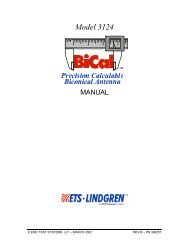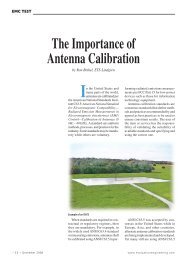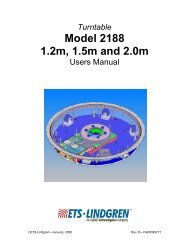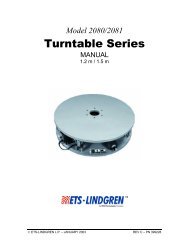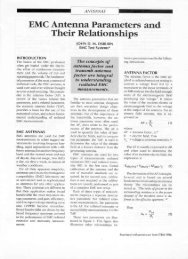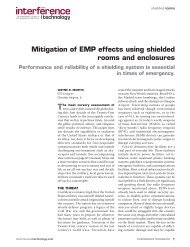You also want an ePaper? Increase the reach of your titles
YUMPU automatically turns print PDFs into web optimized ePapers that Google loves.
HIn3637 <strong>Manual</strong> Page — 25<br />
Integrator Section<br />
The output voltage of the probe sensor coils increases<br />
directly with the frequency of the applied magnetic field.<br />
The integrator provides a flat frequency response.<br />
Post-filter Section<br />
A second-order Butterworth low-pass filter ensures that<br />
only signals below 400 kHz are fed to the RMS<br />
calculation section.<br />
RMS Calculation<br />
The signal from each channel is applied to a separate true<br />
RMS converter and combined through vector addition to<br />
obtain the field magnitude. This value is computed by<br />
the processor and A/D converter. The meter is driven by<br />
outputs configured as a PWM (Pulse-Width Modulator).<br />
The processor performs an A/D conversion on each axis<br />
signal by programming the analog multiplexer, which<br />
feeds the A/D converter. The digital values are squared<br />
and summed; then the square root of the sum is<br />
calculated. This result determines the duty cycle of the<br />
PWM output, which drives the meter movement. The<br />
PWM output frequency is 30 Hz; this is too high to be<br />
visible on the analog meter, but it can be detected on the<br />
recorder output as approximately 50 mV of ripple.<br />
Power supply<br />
A ten-cell NiCd battery powers the HIn3637. The<br />
current consumption of the instrument is relatively low,<br />
yielding a continuous operating time of 20 hours. In<br />
typical daily operation (intermittent use), the operating<br />
time between charges will be much greater. The voltages<br />
required by the analog circuitry are derived directly from<br />
the battery voltage. The digital voltage is supplied via a<br />
series pass regulator.




